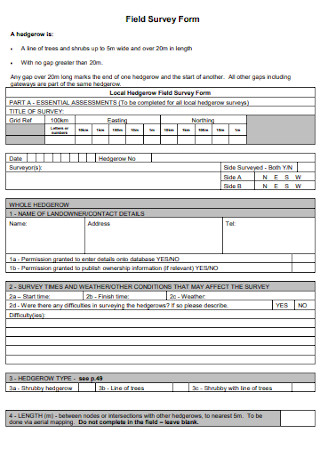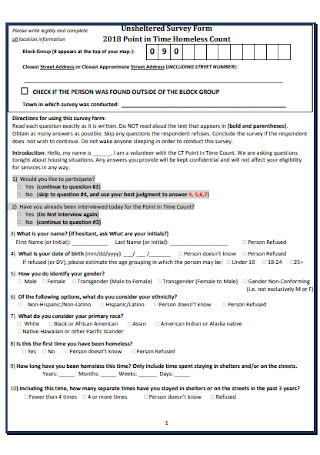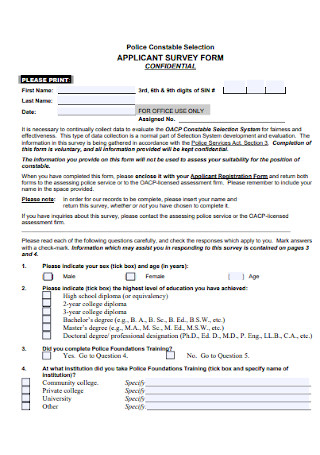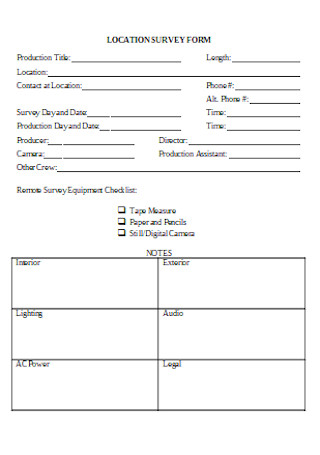50+ Sample Survey Forms
-

Field Survey Form
download now -

Historic Resource Survey Form
download now -

Unsheltered Survey Form
download now -

Supplier Survey Form
download now -

Window Survey Form
download now -

Laboratory Survey Form
download now -

Kitchen Design Survey Form
download now -

Sample Survey Form Template
download now -

Village Survey Form
download now -

Property Survey Request Form
download now -

Student Survey Form
download now -

Community Survey Form
download now -

Teacher Survey Form
download now -

Systems Survey Form
download now -

Family Talent Survey Form
download now -

School Survey Form
download now -

Supplier Quality Survey Form
download now -

Route Survey Form
download now -

Meeting Evaluation Survey Form
download now -

Permit Survey Form
download now -

Self Survey Form
download now -

Survey Inspection Report Form
download now -

Travel Survey Form
download now -

Access Control Survey Form
download now -

Tertiary Survey Form
download now -

Alumni Survey form
download now -

Standard Survey Form
download now -

Historic Building Survey Form
download now -

Mitigation Survey Form
download now -

Symtom Survey Form
download now -

Individual Property Survey Form
download now -

Interior Survey Form
download now -

Event Survey Form
download now -

Valuation Survey Form
download now -

Employer Survey Form
download now -

Seasearch Survey Form
download now -

Applicant Survey Form
download now -

Stem Wall Survey Form
download now -

Worker Discomfort Survey Form
download now -

Vehicle Ridership Survey Form
download now -

Cross Connection Survey Form
download now -

Survey Form Format
download now -

Historic Resources Survey Form
download now -

Infection Control Survey Form
download now -

Field Survey Form Example
download now -

Environmental Risk Survey Form
download now -

Business Survey Form
download now -

Survey Register Plan Form
download now -

Home Survey Form
download now -

Customer IT Survey Form
download now -

Location Survey Form
download now
Survey Forms: What Are They?
Survey forms are important documents used in the process of collecting data from a certain group of respondents to obtain information, opinion, and insights into various topics of interest. While survey forms are commonly being used in this process, survey questionnaires, which can be either online or offline, are also utilized. According to the International Encyclopedia of Human Geography, survey questionnaires are effective tools for gathering statistical information related to the attributes, attitudes, or actions of a population with a structured set of questions. However, it is only suitable depending on the type of information needed to be answered.
Based on the International Encyclopedia of Human Geography, survey questionnaires are as effective as survey forms in gathering statistical information related to the attributes, attitudes, or actions of a population with a structured set of questions.
The Main Benefits of Survey Forms
Survey forms are easy to develop, especially with the help of advanced survey solutions accessible today. Many researchers are tempted to do data collection online. However, it is not the most preferred mode of data collection when it comes to respondents in hard-to-reach areas. Even if you are to use a combination of all modes, the mode should depend on what study you are doing and the demographics of respondents. Here are the main benefits of survey forms to help you decide which mode of data collection to use in your research.
How to Create Survey Forms
The best way to create survey forms is with the help of a template. But you can also start from scratch if you want to create a new format. The best thing about working with a template is that it promotes consistency in your form because it comes in with suggested content. You can choose to keep the suggested content as is or modify it using compatible editing tools. Here are the next steps that will guide you in making your survey form.
Step 1: Open Editing Tool
Before opening an editing tool, select a template first. Start by browsing through our website and discover a collection of different business stencils fitting for any need whether in business or not. After that, open an editing tool on your device. The editing tool should be compatible with your template’s file format. Otherwise, it would be difficult to edit the template.
Step 2: Modify Your Template
Modifying your chosen template is more convenient because it is created by our professional writers and graphic designers. You can let it be or change it if there are some necessary adjustments you want to make. Moreover, you can add designs to make the survey form visually appealing. But do not go overboard. Overdesigning could compromise the convenience a template could contribute.
Step 3: Consider Electronic Forms
Some people or organizations use digitally made forms in conducting surveys. These forms are distributed online and collect information right away. You can do this too as it is more convenient than printing hard copies. However, consider the interest or topic you are making research with before deciding what survey form to use.
Step 4: Finalize the Survey Questionnaire
Survey forms are important documents with structured questions designed to acquire data from a certain group of people. Because of that, it should be very well-written. So, before letting a respondent answer the form, review its content first. The last thing you would want is to obtain faulty data, which are likely useless for your research.
FAQs
Is a survey a questionnaire?
No. The difference between surveys and questionnaires is that a questionnaire is a written tool composed of a set of questions used to gather information from respondents while a survey is both the set of questions and the process of collecting and analyzing responses acquired from the questionnaires.
What are the common types of forms?
- Agreement Form
- Application Form
- Estimate Form
- Consent Form
- Biodata Form
- Membership Form
When is a survey form important?
You can use survey forms to investigate the characteristics, behaviors, or opinions of a group of people. This research tool is also used to ask questions about demographic information about sex, religion, ethnicity, and income.
In knowing that survey forms play an important role as a method of research, it pays to invest in learning how to create effective forms. For more printable templates, go to our website and get the chance to sign up for any of our subscription plans.
